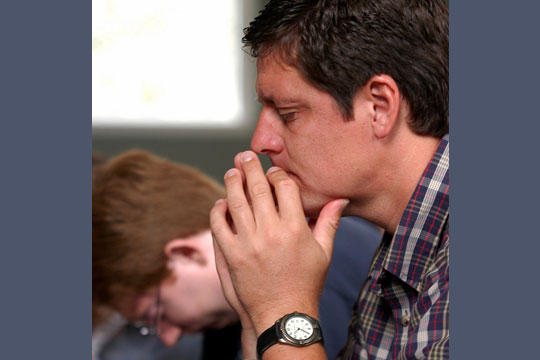
Peter, a director of religious education at a parish, asked Susan if prayer was interwoven into her classroom.
“But I don’t have time to pray with my students and still get all of the material covered!” Susan answered, exasperated.
“The most important thing,” Peter assured her, “is to model a life of discipleship grounded in prayer.”
“Why?” Susan asked.
“Because without the deep breath of prayer,” Peter replied, “our students will never believe that we have internalized our faith, that we call upon the Lord in all that we do, and that it is in and through prayer that we deepen our relationship with Christ.”
Prayer can be an afterthought rather than the first and essential component of parish life. This isn’t a problem confined to religious education programs in parishes; school staff confess that they do not spend time regularly praying together or attending Mass during the course of their day.
Consider the following quote from Fr. Raniero Cantalamessa, Preacher of the Papal Household:
Imagine this scenario: a team of firefighters who hear an alarm rush with sirens blaring to where the fire is. However, once there, they realize they do not have any water in their tanks, not even a drop. That is what we are like when we run to preach without praying. It is not the case that words are lacking; on the contrary, the less one prays the more one speaks, but they are empty words that do not reach anyone. (Homily, 16 March 2016)
While catechists know that they ought to pray with their students, prayer often gets relegated to a quick prayer at the beginning or the end of class rather than woven throughout the class. St. John Paul II reminded us that “the definitive aim of catechesis is to put people not only in touch but in communion, in intimacy, with Jesus Christ: only He can lead us to the love of the Father in the Spirit and make us share in the life of the Holy Trinity.” (Catechesi Tradendae, 5)
For students who attend public school and who are not regularly attending Mass, your classroom might be their only exposure to prayer on a regular basis. This is a tremendous opportunity for evangelization! One of the best ways to model a living relationship with Christ is through the power of prayer. Here are three simple ways to do so.
1. Prayerful Preparation
Incorporate prayer throughout your lesson planning. Call upon the power of the Holy Spirit to help you and give you the words you need while teaching. A simple prayer such as the following can help: Holy Spirit, be with me as I prepare to teach these children of God. Give me the words to speak the name of Jesus to my students with compassion and love. Attune the ear of my heart to listen for opportunities to pray with my students. Help me to look for moments to be your voice, hands, and heart to all those whom I encounter today. I ask this in your name. Amen.
2. Praying by Name
Encourage your catechists to pray for each student by name. As class lists are formalized toward the beginning of the catechetical year, send them to your catechists and encourage them to set aside time to pray daily for each student. You can do this using the following formula: Heavenly Father, as we begin another year growing in faith, I ask you to be close to (insert name). Help him/her to grow in my classroom through the power of the Holy Spirit. I ask this in Jesus’ name. Amen.
3. Prayerful Opportunities
Catechists who actively watch for opportunities to pray with, over, and for students will be blessed by experiences that will surprise and delight them. A catechist friend of mine once confessed that when she prays with her students, the depth of their struggles and joys literally takes her breath away. Not only does prayer help us voice what is in our heart, but it helps us be better listeners—both to God and to one another. After class, take some time to reflect upon your lesson and pray: Jesus, I am thankful for every moment and opportunity to help others to be nourished in faith and for myself to grow in faith. Glory be to the Father, and to the Son, and to the Holy Spirit. Amen.
How do you incorporate prayer into your classroom? What prayerful practices do you use? Please share them with us so that we can share them with others!





A wonderful article reminding us that catechesis is about a person: Jesus Christ. We are called to introduce our children to this Person, and to witness to all He has done in our lives. None of this is possible without prayer. Thank you, Julianne!
Thank you Christina for your kind note and support. You are right, it is all about modeling Jesus!